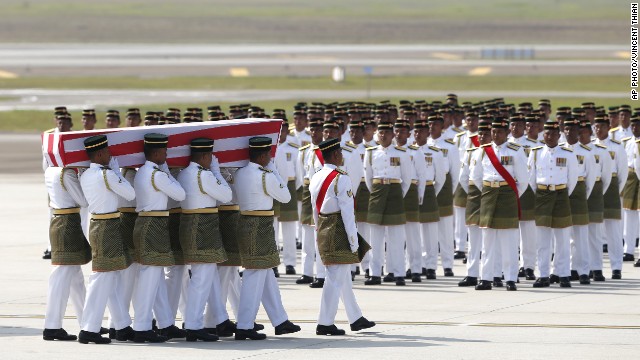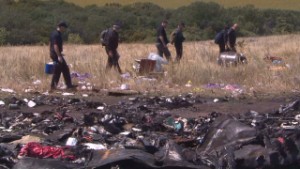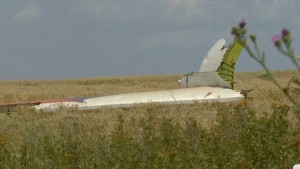First responder: What I saw at Malaysia Airlines Flight 17 crash site
It was late afternoon in Kiev on July 17 when I spotted the tweet: A commercial airliner had been downed over eastern Ukraine.

 Malaysia repatriates MH17 passengers
Malaysia repatriates MH17 passengers


 MH17: What they left behind
MH17: What they left behind
My team, more than 250
civilians from the Organization for Security and Cooperation in Europe,
had been sent to Ukraine three months before to monitor and report on
the security situation in the country and to facilitate dialogue. Now we
were involved in something very different.
As the minutes ticked by,
we raced to verify claims about the plane. Soon it was confirmed: A
Boeing 777 with 298 people aboard it had crashed.

Michael Bociurkiw
It was exactly 24 hours
after Malaysia Airlines Flight 17 fell out of the heavens and into the
farmlands of the Donetsk region when our team of two dozen monitors
arrived on the scene. We knew we were close when we spotted from a
distance the vertical tail, with the Malaysia Airlines logo still
largely intact. It lay peacefully, seemingly untouched, in a wheat
field.
We were the first
international organization on the ground, and with that came an intense,
unprecedented media glare that would last for days. Some referred to us as "the eyes and ears of the world" -- and what we saw was horrifying.
 Malaysia repatriates MH17 passengers
Malaysia repatriates MH17 passengers

Rebel clashes halt MH17 investigation

Eerie silence surrounds MH17 crash site
 MH17: What they left behind
MH17: What they left behind
Our first observations
were of a gruesome scene of smoldering rubble, bodies (some still
strapped into their seats), personal belongings and a bewildered group
of swaggering rebels, uniformed first responders and foreign
journalists. There was no sign of perimeter security. Aside from the
vertical tail, the aft section of the fuselage was among the largest,
intact pieces of debris.
On the opposite side of a
farm road that bisected the main impact site were more terrible scenes:
mangled corpses amid still-smoldering fuselage, duty free shopping bags
and open suitcases. Farther along the hellish landscape was where the
wings, fuel tanks, landing gear and main cabin crashed.
The impact of the jet
smashing into the ground caused a fireball in one field that brought
temperatures as high as 1,600 degrees Celsius, according to some experts
-- enough to melt the aluminum wings of the 17-year-old aircraft and
incinerate everything in the immediate area. Incredibly, the small
village of Hrabove, just a few meters away, remained relatively
untouched.
On Day One, we were only
able to spend 75 minutes on the site. The heavily armed rebel who
appeared to be in charge was largely uncooperative and clearly unhappy
with our presence there. He was aggressive and appeared to be
intoxicated. Journalists on the scene told us that they had been hastily
corralled, apparently to create a semblance of order.
There were many scenes
that defied logic: an opened bag of duty free items with two plastic,
un-pilfered bottles of whiskey, a MacBook Pro laptop, a Lonely Planet
guidebook to Bali -- not a surprising find given that this "backpacker
route" is heavily used by holidaymakers destined for Asia. A few days
later we'd find several passports that had been taken away and then put
back at the crash site, apparently by a guilt-ridden first responder.
What also struck us was
the randomness of how pieces of the plane fell upon this bucolic region
of conflict-ridden eastern Ukraine: a toilet sink here, a business class
seat a few meters away and next to it the horizontal stabilizers. We
were shocked one day to chance upon an enormous piece of the main
passenger cabin, hidden away in the woods. I counted 17 windows, some of
them still intact.
By far the most horrific
scene was four days after the crash, when our team monitored the
sealing up of train cars filled with the remains of the plane's
passengers, at the railway station in Torez (which, ironically, was
where four of our colleagues were kidnapped by an armed group at the end
of May).
The stench of death at
the station was overwhelming. Yet knowing that these souls were finally
on their way home, out of this chaotic scene to a place where they could
be cared for with dignity, provided some sense of comfort. I noted how
the local women from the railway station took great pains to
meticulously seal the car doors -- perhaps feeling in some small way
that they had aided the families of the victims.
It was during these
first crucial days that our team was able to facilitate access for four
small groups of experts: a team of civil aviation experts from Kiev, a
three-member team from Malaysia Airlines and that country's department
of civil aviation, along with Dutch and Australian experts. I marveled
particularly at the stoicism and composure of the Malaysian experts:
These are men who live and breathe aviation, and they knew the aircraft
intimately.
The tragedy struck
deeply for me as well. I had lived and worked for many years in
Malaysia, have many friends there and am very familiar with the country
and the airline. My roots are in Ukraine, and I've covered commercial
aviation as a journalist and I've a well-known fondness for flying.
At least at the end of
every day, we were able to retreat to the relative comfort of our hotel
in Donetsk city. But even there, the threat of violence was never far
off. Late one night, standing on the hotel rooftop waiting to go live on
TV with CNN's Erin Burnett, the sound of automatic gunfire sent me and
the Turkish crew rushing for cover. I ended up speaking to Erin crouched
down near a protective wall.
On August 1, after
almost a week-long pause due to security reasons, we were able to
establish a new access route that paved the way for daily visits by a
critical mass of Dutch and Australian experts to the MH17 crash site.
To finally see dozens of
trained sets of eyes combing over the site, starting with the chicken
farm near Hrabove, brought us all a sense of accomplishment. As images
of the uniformed experts surveying the fields, aided by sniffer dogs,
were flashed around the word by the media and via social media, I
thought to myself that this must have brought some sense of comfort to
the families of the victims. And after days of waiting in Donetsk, I
know that the Dutch and Australian experts -- despite the grim task
ahead of looking for victims' remains and personal belongings, as well
as the dangers of working a crime scene in the midst of an active
conflict zone -- could not wait to get down to work.
The sounds of shelling
in the distance were a constant reminder of the threat. Little wonder
that during an orientation session, one of the commanders instructed the
experts to "treat every day here as if it is your last day on site."
I am often asked how we
coped with the enormity of all this, of the horrific scenes we
witnessed. What powered us through this was knowing that we were
providing families with crucial bits of information in those chaotic
first days.
As always, our hearts
and prayers are with the victims' loved ones, and we hope that we have
been able to provide them with some sense of comfort and closure to this
horrific tragedy.










0 comments:
Post a Comment